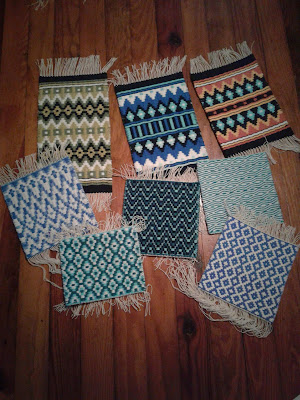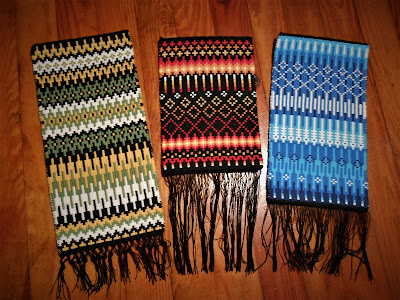I am lucky enough to live only a few hours away from the Red Stone Glen fiber arts center. I took advantage of this in August 2020, when I finally made it out there to take a three day class with the great Tom Knisely. The class was on 4-shaft boundweave, and I will never be the same weaver again.
 |
| My finished sampler from Tom Knisely's Boundweave class |
Way way back in the infancy of my life as a weaver, I accidentally discovered the technique of weaving-on-opposites. I was figuring out how to weave rag rugs using turtlenecks for weft and acrylic knitting yarn for warp. The warp was ugly and terribly fluzzy. I figured that by lifting the opposite shafts after every regular pick of the pattern, and throwing a pick in the opposite shed to sort-of lock it in place, I could manage to cover every warp thread in every pair of picks and let my (relatively) attractive weft take prominence.
 |
| My first-ever rag rug (March 2018) |
 |
| My personal workspace on day one |
After that, things got exciting, as Tom taught us three other methods of treadling to produce boundweave patterns with 3 or 4 colors. I might have figured these out on my own -- eventually, maybe -- but there's no substitute for having a teacher there in person to tell you these things. It was the tiny little tips and tricks that turned out to be the most helpful, like how to keep the edges tidy when you're rotating through three or four shuttles by keeping them in the proper order on your bench. It was also rewarding to discover that I can, in fact, sit down and weave for eight or nine hours in a day. I tend to be flighty and easily distracted when left to my own devices, so this was good to know.
 |
| Done weaving on opposites, starting the 3-color rotations |
After three days, I sadly had to leave the Glen and go home. But my boundweave journey had just begun. I immediately warped up my trusty Hammett floor loom in rosepath to try out all the patterns and variations that I could think of, based on what we'd done in class and the possibilities that the weaving structure suggested. My favorites were the samplers in what Tom called "large flame" treadling, which have the look of saddle blankets. Some day I would love to weave a full-size saddle blanket, now that I know how it's done.
 |
| Boundweave samples back at home |
At some point during the class, I had also talked to Tom about krokbragd, which is basically boundweave on three shafts instead of four. I'd been curious about it for a while and I'd even struggled through a small sample of it in a frame loom a year earlier, but it had been a struggle. (No doubt the frame loom had something to do with that.) Now that I knew I could handle boundweave, though, my curiosity about krokbragd took on a new intensity. Tom talked me over a few different ways to thread & tie up a 4-shaft loom to do a 3-shaft draft, and I went home armed with the knowledge to test it out for myself. Right after I worked the boundweave sampling out of my system, I immediately turned to krokbragd, and absolutely fell in love. Below are my first three cotton samplers in krokbragd. The leftmost one is genuine traditional krokbragd. Not content to stick with the infinite pattern possibilities of mere krokbragd, for the other two samplers I added a pick-up stick so I could try out the even more exciting possibilities of danskbrogd.
 |
| Experimenting with 3-shaft krokbragd |
Ultimately, more than anything else what Tom's class gave me was a sense of confidence and ease going forward. I'd done a bit of boundweave and krokbragd on my own before, but it hadn't been exactly comfortable. After the class, I've taken to it like a duck to water. My tension problems are gone, my edges are crisp and tidy, and I feel like I can handle anything. I don't know how he does it, but it felt like magic.
Comments
Post a Comment